3 Of The Most Spine-Chilling Stories Of Ghost Ships From History
Throughout history, the oceans have whispered chilling stories of vessels adrift without a soul in sight, haunting the seas with their spectral presence.
The lore of ghost ships is filled with spine-tingling accounts that defy explanation, from the eerie disappearance of entire crews to the inexplicable sightings of abandoned ships sailing aimlessly.
Today, we’ll delve into 3 of the most frightening stories of “ghost ships’ from maritime history. Scroll through to discover them.
The MV Joyita was discovered adrift and deserted in the South Pacific in 1955
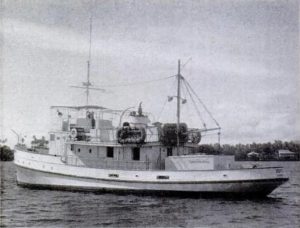
One of the most enduring mysteries of the South Pacific is the disappearance of the merchant vessel M.V. Joyita.
In October 1955, the ship set sail on a routine 500 km journey from Samoa to Tokelau with 25 passengers and crew. Five weeks later, it was found drifting near Fiji with no one on board.
The story begins at dawn on Monday, October 3, 1955, in Apia harbor, Samoa. The 70-foot Joyita departed for Tokelau, carrying goods for White Sunday, a medical officer set to perform an amputation, two pharmacists with urgent medical supplies, and other passengers and cargo.
Apart from one passenger carrying a large sum of cash to buy copra, there was nothing unusual on board.
The Joyita was originally scheduled to sail at noon the previous day but was delayed due to a failed port engine clutch.
Despite the crew’s efforts to fix the problem overnight, Captain Thomas Miller, needing these government-chartered runs to pay off his debts, decided to leave port with only one functioning engine. He also knew the radio and pump were faulty.
The journey was expected to take 41-48 hours.
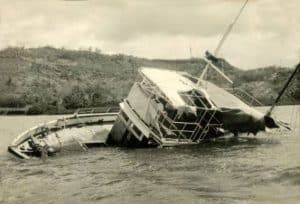
By noon on Wednesday, October 5, the Joyita had not yet arrived. The weather was calm, and no distress calls had been reported by any passing ships or land-based stations in the area.
As the hours passed, 3 o’clock came and went, then 6 o’clock, with no sign of the vessel. On Thursday, October 6, officials in Fakaofo, one of Tokelau’s three atolls, sent out a message: “The Joyita is overdue.”
A search and rescue mission was launched immediately. From October 6 to 12, Sunderland flying boats from the Royal New Zealand Air Force scoured over 100,000 square miles of ocean, looking for any trace of the Joyita.
On the morning of November 10, Captain Gerald Douglas of the merchant ship Tuvalu saw something unusual in the waters north of Fiji. As the Tuvalu drew closer, it became clear that the ship was in trouble.
It was listing heavily to port, with its railing dipping in and out of the sea, and no one was visible on deck. The name on the hull read Joyita.
The Joyita had been outfitted with a dinghy and three Carley lifeboats, but all were missing. With 25 people on board, the lifeboats would have been nearly full if they had been used for an escape.
In February 1956, a formal inquiry was conducted in Apia to investigate the fate of the Joyita. The inquiry concluded that the vessel was in poor condition but found the disappearance of the passengers and crew “inexplicable on the evidence submitted at the inquiry.”
The Ryou-Un Maru, a Japanese fishing vessel, swept out to sea by a tsunami, was found in 2011

The story of the Ryou-Un Maru is quite different from other ghost ship tales we’ve heard. This fishing vessel didn’t have crew members or passengers aboard when it met its fate.
Instead, it was an unmanned boat that was swept out to sea by the massive earthquake and tsunami that struck northeastern Japan in March 2011.
Constructed around 1982, the Ryou-Un Maru was built for a fishing company based in Hokkaido. It spent many years as a shrimping boat until it became too old for use.
The company retired it to Honshu and listed it for sale, but the 2011 earthquake and tsunami hit before it could find a new owner.
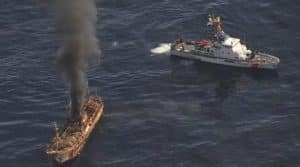
By April 2012, the Ryou-Un Maru had drifted into the Gulf of Alaska, posing a hazard to vessels navigating that busy area. It was located roughly 180 miles west of Alaska’s southeast coast.
The vessel was thrown into the Pacific by the disaster, where it drifted aimlessly for months. The owners, convinced it had sunk during the catastrophe, canceled its registration. Surprisingly, about a year later, the unmanned boat was spotted by the Canadian Coast Guard.
In response, the U.S. Coast Guard decided to use cannon fire to sink the “ghost ship.” Chief Petty Officer Kip Wadlow told The Associated Press that it took roughly four hours for the ship to finally submerge into waters about 6,000 feet deep.
In 1921, the Carroll A. Deering was abandoned off the coast of North Carolina
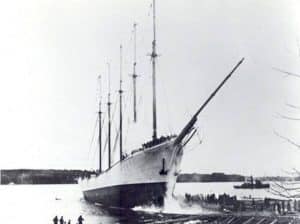
The American schooner Carroll A. Deering, built in 1919, was intended for commercial use. However, a mysterious event onboard led to its premature retirement after just a few years in operation.
The Deering set sail from Puerto Rico on July 19, 1920, reaching Newport News to load a cargo of coal for a trip to Rio de Janeiro. The ship was under the command of William H. Merritt, a decorated World War I hero, and his first mate was his son, Sewall.
Their crew consisted of ten Scandinavian sailors, predominantly Danes. The Deering departed from the Virginia Capes on August 26, 1920, heading toward Rio.
Unfortunately, Captain Merritt became gravely ill, forcing the ship to return to Lewes, Delaware, where both Merritt and his son disembarked.
The company then appointed Captain Willis B. Wormell, a retired 66-year-old veteran, to lead the voyage to Brazil. Additionally, Charles B. McLellan was brought on as the new first mate.
In early January 1921, while the crew was in Barbados, McLellan got drunk and ominously declared, “I’ll get the captain before we get to Norfolk, I will.” He had already threatened to kill Captain Wormell, adding to the tension on board.
By January 9, 1921, the crew began their journey back to the U.S., heading towards North Carolina, near Cape Lookout Shoals.
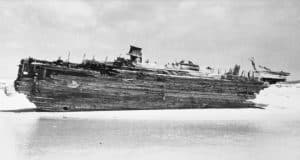
On February 3, 1921, The Washington Herald reported a chilling sight: “Like a ‘Flying Dutchman,’ the five-masted schooner Carroll A. Deering loomed through the mists about Diamond Shoals today, all sails set, but un-manned.”
In late January 1921, the schooner Carroll A. Deering was discovered abandoned off the North Carolina coast. Spotted near Cape Hatteras on January 31, the ship appeared in good shape, yet it ran aground on the treacherous Diamond Shoals.
When the Coast Guard boarded the vessel, they found the sails set and food prepared but untouched. Everything seemed normal – except for the complete absence of the captain and crew.
The lifeboats were missing, and there was no trace of the twelve men who had set sail from Barbados to Norfolk, Virginia. What happened to them remains a mystery. Could they have fallen victim to pirates, been captured by Russian spies, or is this another enigma of the Bermuda Triangle?
Debates ran through the pages of newspapers, and yet to this day, no one knows the true story.

